Norway-Land of the Red, Yellow, and White Houses Posted by kari on Aug 31, 2010 in Culture, Nature
As I was walking to Tromsø sentrum yesterday, my eyes were drawn to the red and yellow everywhere. Red, yellow, and actually white-3 colors that one sees a lot of in every village, town, and city. White is the most popular color for houses, but the red and yellow come in second forsure. You rarely ever see a brown, tan, or gray house like you do everywhere in the U.S. (especially in suburbs).
I´m not really sure why the colors that are more popular in the U.S. aren´t found in the Norwegian residential landscape, but I do have speculations about the abundance of red, yellow, and white. I was talking to a friend yesterday who is a tourist guide here in Tromsø and I asked him if he knew the answer to my question. Sure enough, he knew at least part of the reason for the presence of these colors. A glimpse back into history…
The color that homeowners would choose to paint their houses depended heavily on their financial situation, their geographic location, and their profession. The resources used to make certain colors were of varying worth and again were dependent on location and access to resources.
Red, the cheapest color to produce, was made using the blood and oil from fish and other animals. So, if you lived by the coast and were a fisherman, you probably didn´t have a lot of money and there you have it-a red house. Yellow paint, according to my tour guide friend, was, slightly more expensive, and was made with ochre and oil. White was the classiest color of all. In order to make white paint way back when, you needed zinc, which was quite expensive. Therefore, if you had a white house, you showed your neighbors that you had money. It was common for people who lived on the coast to paint the side of the house facing the water white and the other 3 sides red, for example. Seems silly, but I suppose it´s not much different than people today who drive fancy cars and have crappy houses, or who have nice looking houses on the outside and are repulsive on the inside. People in general, at least in the western world, are very concerned with the image they portray to the world.
History or not, I love looking out over a span of Norwegian houses. I think red, yellow, and blue are great colors to paint a house. They are never boring, they are very different from one another, and they make me happy when I look at them. I personally think of love (rather than blood…), the sun, and the ocean. All very happy things! Not such a huge fan of white, but if the design is unique, then it can be absolutely beautiful!

Build vocabulary, practice pronunciation, and more with Transparent Language Online. Available anytime, anywhere, on any device.
About the Author: kari
I attended St. Olaf College in Northfield, MN, where I majored in Norwegian and History. During college, I spent almost a year living in Oslo, Norway, where I attended the University of Oslo and completed an internship at the United States Embassy. I have worked for Concordia Language Villages as a pre-K Norwegian teacher and have taught an adult Norwegian language class. Right now, I keep up by writing this Norwegian blog for Transparent Language. Please read and share your thoughts! I will be continuing this blog from my future residence in the Norwegian arctic!



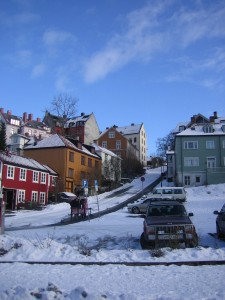
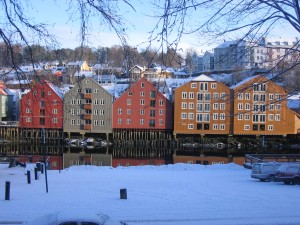
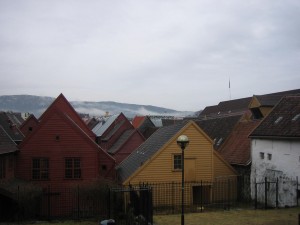
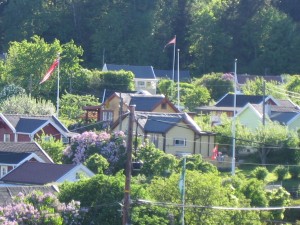
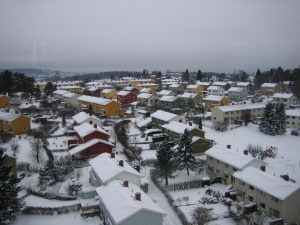
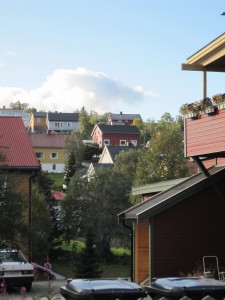

Comments:
BM:
I believe the red (Falu red) is actually copper-based, not blood-based. We see these colours particularly in areas where the Hanseatic league had a base; I would bet my bottom dollar that emulation of the Hanseatic traders is the reason that Norwegians began painting their houses these colours.
Sarah Kelley:
One of the things I love about Norway is that houses are a variety of different colors.
I read a story about a woman with cancer in California who painted her house sea-foam green, in part to help cheer herself up. She got death threats from her neighbors because of the color! It was really sad.
eirik:
Red was the cheapest colour. That is why so many barns around the countryside also is red
kabjen13:
I learned that in rural areas of eastern Norway, farms generally had both white and red buildings. Houses were always white, and barns and other buildings on the property were red. It still looks that way today. And even the colour of paint trim could symbolise factors such as family heritage or regional distinction. Similar to how bunads all look very distinct from each other.
Bjørn A. Bojesen:
@kabjen13 Hi kabjen13, yes I noticed that also. If you go to the neighbouring area in Sweden (like Värmland) you’ll a great many red farm houses. So, pershaps it’s an influence from Sweden?
Mihaela:
I live in northern part of Oslo in a yellow house and most of my neighbours have red and dark green houses. I was told the same story about the red colour.
All the houses look gorgeous in the winter time, when everything else is just white and grey.
Lois:
I had a young students who suggested all the houses in our American suburbs are the color of fog and bandaids. So true!! I love the colorful houses in Norway. I also read a book about the falu red color coming from copper.
Bjørn A. Bojesen:
@Lois Hello Lois. Thanks for your feedback! Yes, the Norwegian houses are beautiful. Interesting detail about the copper, thanks for sharing! 🙂
Kristine Matson:
I am thinking about buying a farmhouse in northern WI that was built by Norwegian farmers over 100 years ago. It is the dark red you describe with white trim. I want to carry on the tradition with any remodeling or outbuildings I add. I love the dark red and gold combination I saw the two times I visited Norway. By the way, my mom went to St. Olaf, I lived in Northfield for awhile, I went to Concordia in Moorhead, and my sibs went to the Norwegian Language Camps! Hope you are doing well.